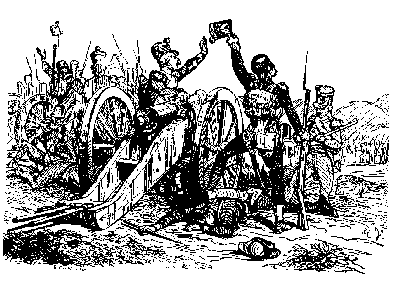Slavkov u Brna - Austerlitz
Slavkov u Brna - Austerlitz |
 The Battle of Austerlitz brought end to the third
anti-French coalition, the military pillars of which were Russia and Austria, with
financial backing from England. It belongs among the bloodiest battles of the Czech lands'
entire history. The Allies were lead by the Austrian Emperor Francis I. and the Russian
Tzar Alexandr I. Against them stood the 36-year-old Emperor of the French, Italian King,
and the mediator of the Swiss confederation, Napoleon I. Bonaparte.
The Battle of Austerlitz brought end to the third
anti-French coalition, the military pillars of which were Russia and Austria, with
financial backing from England. It belongs among the bloodiest battles of the Czech lands'
entire history. The Allies were lead by the Austrian Emperor Francis I. and the Russian
Tzar Alexandr I. Against them stood the 36-year-old Emperor of the French, Italian King,
and the mediator of the Swiss confederation, Napoleon I. Bonaparte.
Russo-Austrian army had 90,000 men, out of which, however, only 15,000 were natives of the Habsburk Monarchy. The chief commander of the coalition was 60-year-old Russian general M.I. Goleniscev-Kutuzov. The staff work, on the request of the Tzar, was performed by Austrian officers. Major general Franz von Weyrother worked out the operational plans of the battle. Due to their immoderate selfconfidence and unsufficient reconnaissance the Allies presumed that Napoleon is rounding his troops around Brno and will accept defensive role in the battle. According to their plans the right wing of the French army was to be attacked and, through a joint effort of the center and the right wing of the Allies' troops, all the Franch units were to be surrounded in the area South-East from Brno. To fulfil this task the army was divided into vanguard, five columns, independent Bagration's corp on the right wing and reserve troops, consisiting of the Russian Imperial Guard.
Napoleon's tactics was based on the knowledge, gathered through advanced reconnaissance, of the Allies' position, on the exact psychological estimate of enemy's scheme, on new tactical elements, and, last but not least, on the outstanding abilities of his young officers.
French army, which also comprised an Italian guard and several Bavarian corps, and whose 75,000 soldiers and officers were well outnumbered by the Allies, took up a 7.5-mile-long operational line between the fortified Santon hill on the North, and the village of Telnice on the South. Almost half of the French army were concentrated near Pratecka hills. Seven French marshals accompanied three army corps, reserve cavallery and the guard.
According to the Gregorian calendar, the battle took place on Monday, December 2, 1805. Russians, using the Julian calendar, dated the battle November 20, 1805. The victorious French, using the revolutionary calendar dating from 1793, fought the battle on the 11th of Frimair in the year XIV.
After minor squirmishes during the night, three Allies columns with the Austrian vanguard attacked, after seven o'clock in the morning, the French positions on the line between the villages Sokolnice and Telnice and conquered both villages before ten o'clock. Hidden by thick fog, the French corps I and IV headed towards Pratecke hills and, just after eleven o'clock, began to endanger the rear of the Allies army in the Golden Stream Valley. Around eight o'clock, Bagration launched an attack along the Olomouc road against the Santon hill and conquered the village of Tvarozna. One of the French divisions managed to penetrate into a three-mile-wide gap between the Allies' right wing and their position on Pratecke hills. The success of the French army's centre was thus expanded to its left wing. Bagration was forced to retreat. Neither the cavalry attacks between the villages of Holubice and Kruh, nor the futile attempt by the Russian guard to defeat the French on Stare Vinohrady hill brought any reversal to the fate of the battle.
The break-through of the centre of the Russo-Austrian army jeopardized the rear of the columns which were gathered around the villages of Sokolnice and Telnice. A tardy effort to retreat from the battle line through the Litava valley and later around the Zatcansky pond ment a loss of canons and a capture of sveral thousands of the Allies' men. The battle ended just after four o'clock by the total defeat of the Allies after nine hours of furious fighting.
The Allies lost 40% of the total of all their troops. The French lost 12 % of soldiers who actually took part in the battle. In about 25 mass graves 18,000 of men from all the three armies were buried. Having signed the armistice on December 6, 1806, at the Slavkov (Austerlitz) chateau the peace treaty was signed in Bratislava on December 26. Austria had to cede 66,000 square kilometers of its territory and thus lost three million of it inhabitants and one seventh of its national product. It also had to pay 40 million florins of war reparation. The Battle of Austerlitz (which took place exactly on the first anniversary of Napoleon's coronation) confirmed Napoleon's position in Europe and brought end to the thousand-year-old Holy Roman Empire.